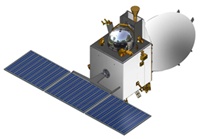ISRO performs first trajectory correction on Mars Orbiter
11 Dec 2013
The Indian Space Research Organisation (ISRO) has successfully carried out the first trajectory correction manoeuvre of the Mars Orbiter spacecraft, the country's maiden interplanetary mission, by transferring the spacecraft to a solar orbit, nearly 3 million kilometres away from the Earth.
 ''The first trajectory correction manoeuvre (TCM) of spacecraft was carried out successfully at 06:30 hrs (IST) by firing the 22 Newton thrusters for a duration of 40.5 seconds. The spacecraft is travelling at a distance of about 2.9 million km away from Earth,'' ISRO said in a release.
''The first trajectory correction manoeuvre (TCM) of spacecraft was carried out successfully at 06:30 hrs (IST) by firing the 22 Newton thrusters for a duration of 40.5 seconds. The spacecraft is travelling at a distance of about 2.9 million km away from Earth,'' ISRO said in a release.
The trajectory correction manoeuvres are intended to keep the spacecraft on a steady course by fine tuning the trajectory of the spacecraft towards the red planet.
At present, the spacecraft is travelling some 2.9 million km away from Earth on a solar orbit intended track.
ISRO placed the Mars Orbiter spacecraft in the Mars transfer trajectory in the early hours on 1 December 2013, after a successful manoeuvre firing the spacecraft's 440 Newton liquid engine for about 22 minutes, thereby raising its velocity by 648 meters/second.
Following the completion of this manoeuvre, the Earth orbiting phase of the spacecraft has ended. The spacecraft was placed on a course to encounter Mars after a journey of about 10 months around the Sun.
Ever since, navigators were assessing the spacecraft's velocity and its precise flight path to come up with the required correction in the path, ISRO said in its Facebook posting.
"Based on this, the firing duration and delta-v has been calculated, which will correct the deviations before they have a chance to grow large. During the trajectory correction manoeuvre, accelerometers on board MOM gives the information when the desired delta-v is achieved," it said.
Today's correction was carried out by the spacecraft's on-board computer, since the amount of time required for the signal to go and return was about 20 seconds, as the Mars Orbiter was at a distance of about 2.9 million km, ISRO said.
"MOM [Mars Orbiter Mission] team is gaining hands-on experience in handling the communication delay as it keeps increasing gradually," it said.
ISRO has provision to fine tune the spacecraft's trajectory four time before it reaches the Martian orbit.
Mars Orbiter will use monomethyl hydrazine as fuel and dinitrogen tetroxide as oxidizer during all the four trajectory correction manoeuvres on its 680 million km journey towards Mars over the next 300 days.
ISRO successfully injected the 1,350-kg Mars Orbiter spacecraft (Mangalyaan) into the orbit around the earth, using the PSLV C-25, some 44 minutes after the launch at 2.38 PM from the Satish Dhawan Space Centre at Sriharikota on 5 November.
Since then, the Rs450-crore mission has been progressing as planned.






























